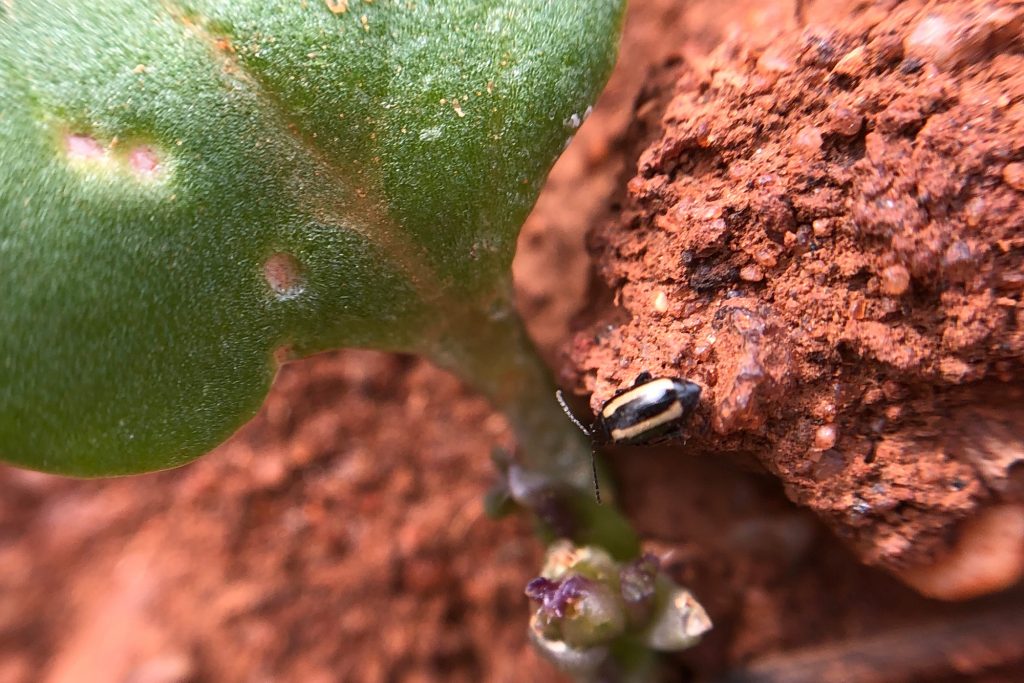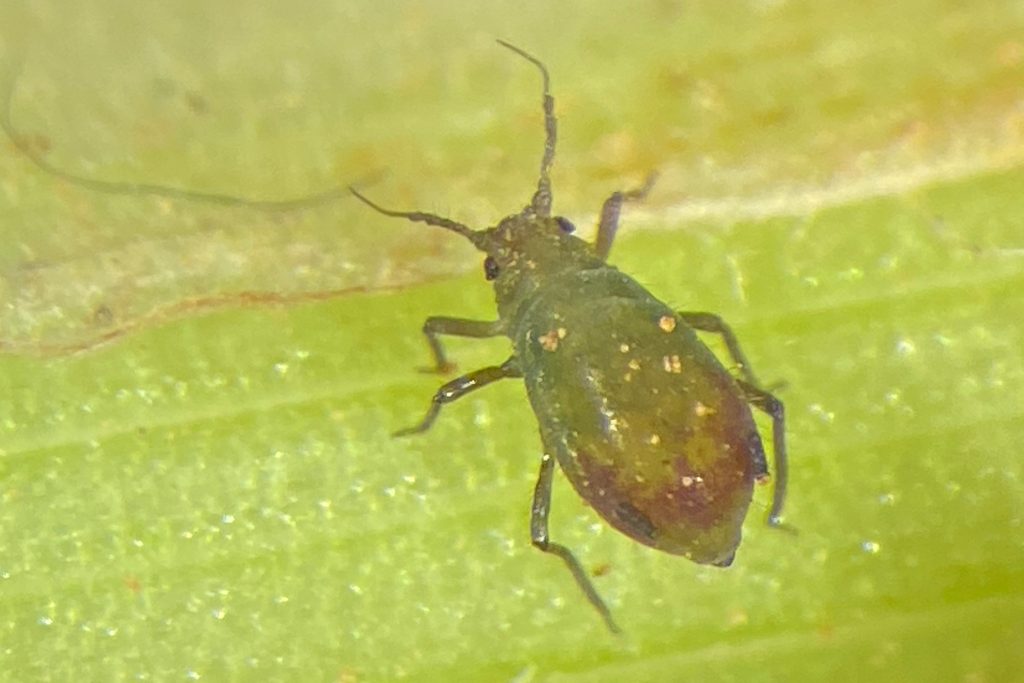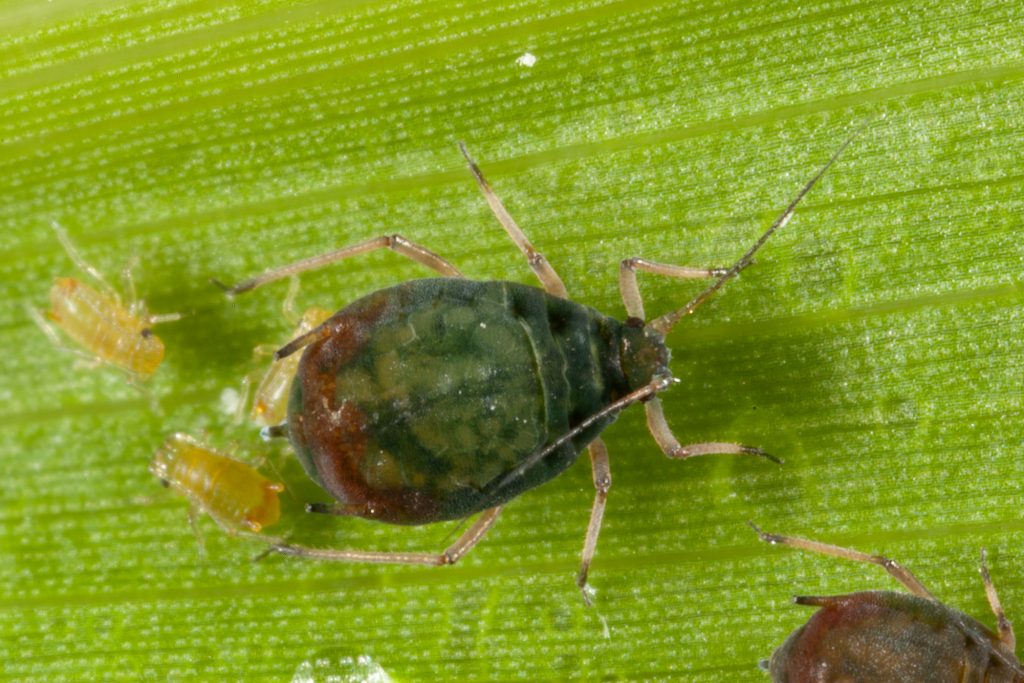Every year we receive reports of out-of-the-ordinary invertebrates in crops amongst the usual suspects.
But this year has been a little more atypical on the invertebrate front; we’ve received quite a medley of unusual reports this winter cropping season.
Here are three atypical cases we’ve received recently from New South Wales:
Flea beetle
Minor and patchy flea beetle damage was observed around Narromine and Condoblin in canola.
Agronomists were alerted to their presence after seeing lucerne-flea like damage where lucerne flea wasn’t present.
On closer inspection, a species of small black flea beetle with yellow stripes was found; their ‘jumping’ behaviour made them difficult to detect.
These were most likely the lesser striped flea beetle (Phyllotreta undulata), a known pest species that is present in Australia.
Flea beetles (Phyllotreta spp.) are a major pest of establishing canola in several countries in the northern Hemisphere, but not in Australia.
While the lesser striped flea beetle is a pest species, it is considered minor compared to the striped flea beetle (Phyllotreta striolata) and the crucifer flea beetle (Phyllotreta cruciferae), two major canola pests that aren’t present in Australia.
The flea beetle damage was not extensive or concerning enough to warrant control at the time of detection.
Given that Phyllotreta spp. hibernate during winter in the northern hemisphere, they aren’t expected to remain active.

Photo by Michael Harris 
Photo by Michael Harris
Rice root aphid
Rice root aphid (Rhopalosiphum rufiabdominale) have been detected colonising the roots and bases of wheat plants around Dubbo, Narromine and Trangie in the Central West Slopes and Plains.
This aphid is related to the oat aphid (Rhopalosiphum padi) and corn aphid (Rhopalosiphum maidis), which are also found on cereals.
The rice root aphid looks particularly like oat aphid as they both have a large red patch across their ‘exhaust pipes’ (siphuncles).
However, the rice root aphid often tends to have a more golden hue compared to oat aphid, which often appear greener. The rice root aphid also has shorter antennae than oat aphid, and they often look like bull horns.
Unlike oat and corn aphid, which tend to colonise above ground parts of plants, the rice root aphid primarily colonises roots, although populations can start to creep up towards the plant base and crown.
In over a decade of data, PestFacts south-eastern does not have any records of rice root aphid troubling cereals in Victoria and southern NSW, despite its known presence in south-eastern states.
They are frequently seen in broadacre crops in the northern region; however there, they aren’t a key pest and aren’t regarded as a reason to use a prophylactic seed treatment.
Based on the northern experience with rice root aphid, we don’t expect their feeding to be an issue in winter cereals (unless they are feeding in very high numbers), particularly under good growing conditions.
Rice root aphid have been reported in healthy crops and their presence was only detected because plants were pulled up in routine crop inspections.
They have also been detected on some unhealthy plants.
If rice root aphid is found on unhealthy plants, be sure to check healthy plants in close vicinity for their presence to indicate if they are the likely cause or not.
Also keep in mind that aphids are known to colonise and ‘bully’ plants that are already stressed, so their presence could be secondary, not the primary cause of damage.
Rice root aphid has been named as a vector of Barley yellow dwarf virus in the scientific literature, however it is unclear as to whether its status is equivalent to that of key vectors oat aphid and corn aphid.
In any case, use of insecticides against rice root aphid in established plants is discouraged given that it is a minor pest and that the aphids are mostly subterranean, and are likely not exposed enough to enable good contact.
Beneficials can still help to reduce their numbers, including parasitoids, which have been seen locating these aphids despite their subterranean behaviour.

Photo by Julia Severi, Cesar Australia 
Photo by Andrew Weeks, Cesar Australia
Leafhoppers
Adult leafhoppers or jassids have been spotted in paddocks on establishing crops since May, including in canola, in the northern Riverina and Central West Slopes and Plains.
Reported numbers have been low but widespread (e.g. 1 – 2 adults on some plants) and we have not received reports of them reproducing on plants.
Leafhoppers belong to the same order of insects as aphids and true bugs (Hemiptera). They are elongated and wedge-shaped, growing to around 3 mm and are very flighty. Adults hold their wings like a roof over the body at rest and can look like tiny moths. Immature nymphs are wingless.
Leafhoppers are not a typical establishment pest in the winter-cropping season and are more common in summer crops.
Leafhoppers are ‘sucking’ insects. If they were causing damage, it would be as white stippling on leaves and/or yellowing. They can also transmit diseases, although the risk of this occurring this season and in particular crops (e.g. canola) is unknown.
Leafhopper activity is favoured by warm conditions, so cooling temperatures means they are unlikely to persist for much longer.
If you are concerned about leafhoppers in your crops, please get in contact so that we can arrange for you to send in a sample; we are not able to identify the species by images.
Acknowledgments
Thanks to the following for providing field reports: Michael Harris (AGnVET), Adam Pearce (Elders), Dean Walton (Nutrien Ag Solutions), Rodney Krueger (Delta Agribusiness), Terry Edis (Elders), Pat Connell (Elders)
Thanks to Dr Melina Miles and Dr Peter Ridland for providing information on rice root aphid.
Cover image: Photo by Rodney Krueger





